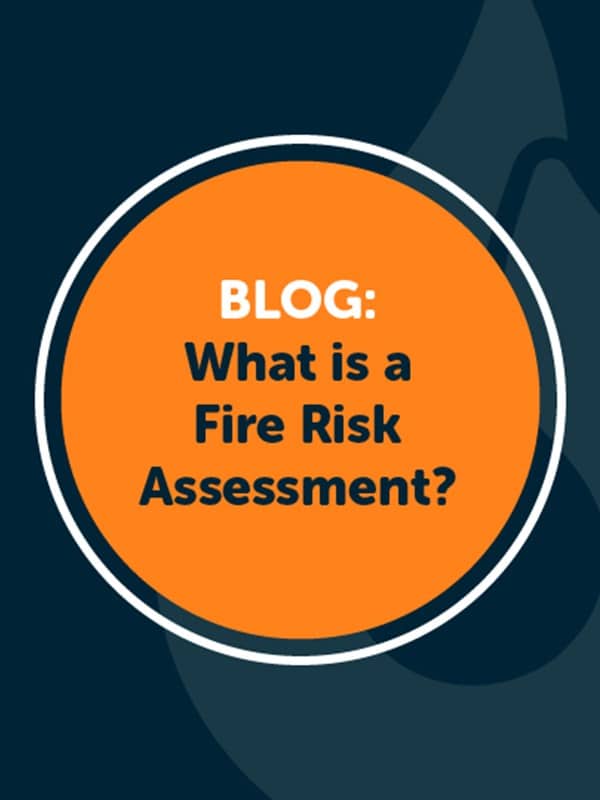A Fire Risk Assessment (FRA) is an essential component of your organisation’s overall Fire Risk Management Strategy.
As with all fire safety measures, the primary goal of a risk assessment is to keep people safe. Virtually all buildings in England are Wales are required, by law, to undertake a Fire Risk Assessment (except for domestic dwellings).
This article will explain the process of carrying out a Fire Risk Assessment, your responsibilities under Fire Safety legislation, as well as proposed changes as to who can carry out an assessment.
What happens in a fire risk assessment?
A fire risk assessment is an audit of a building’s current fire safety measures. If necessary, the assessment will include detailed recommendations to improve its fire safety.
It is an organised, methodical, and thorough look at your premises, the activities carried on there and the likelihood that a fire could start and cause harm to those in and around the premises.
The main aims of a fire risk assessment are:
The aim of a fire risk assessment is to:
- Identify the potential fire hazards including sources of ignition and sources of fuel
- Identify people at risk including people especially at risk e.g.
- Evaluate, Remove, Reduce and Protect from risk
- Record, Plan, Inform, Instruct, Train
- Monitor, Review and Revise as required
Good management of fire safety is essential to ensure that fires are unlikely to occur; that if they do occur, they are likely to be controlled or contained quickly, effectively, and safely. Also, if a fire did occur and spread, everyone in your premises can escape to a place of total safety, easily and quickly.
Fire hazards and risks
The terms ‘hazard’ and ‘risk’ are used frequently throughout the fire risk assessment. Let’s define those words now, as it can be overwhelming to see such alarming words relating to your business!
A hazard is anything that has the potential to cause harm.
Whereas a risk is the chance of that harm occurring.
It’s like going back to your driving lessons! A child riding a bike on the side of the narrow road is a hazard, so you reduce the risk of an accident by slowing down and being more alert.
For example: storing flammable or dangerous substances on your premises is a hazard and the risk is how likely it is to ignite. The risk may be reduced but the hazard remains.
Knowing how to interpret your fire risk assessment will also help you better understand fire hazards and how to reduce the risk of serious incidents.
The Fire Safety Order, which is legislation covering England and Wales, recommends the Five Step Approach in its fire risk assessment guidance:
Step 1: Identify the fire hazards
This step involves identifying any potential sources of ignition, such as fuel, oxygen or anything else that’s flammable, including electrical items.
Step 2: Identify people at risk
You must consider all the people who use the premises, but you should pay particular attention to people who may be especially at risk. This could be members of staff, visitors, or the general public.
Step 3: Evaluate, remove, or reduce the risks
The next step in conducting a fire risk assessment is to evaluate the risk of a fire occurring and consider the risk to people.
You should consider:
- Fire detection and warning systems
- Firefighting equipment such as extinguishers and hose reels
- Escape routes and their accessibility
- Emergency lighting
- Signage, notices, and communication during an emergency
- Maintenance of all the above ☝
Step 4: Record, plan, inform, instruct and train
Record your significant findings including action taken and prepare an emergency plan.
- Inform and instruct relevant people.
- Co-operate and co-ordinate with others
- Provide appropriate training to those who need it
Step 5: Regularly Review
Keep your fire risk assessment under regular review and revise where necessary, for example if the layout of your building or premises changes over time.
Is it a legal requirement to conduct a Fire Risk Assessment?
Yes. The Regulatory Reform (Fire Safety) Order 2005 is legislation that covers England and Wales. It sets the standard for fire safety in all non-domestic premises. (Scotland and Northern Ireland have separate fire safety legislation)
The National Fire Chiefs Council (NFCC), who are responsible for enforcing this legislation tells us in their “Enforcers Guidance”:
“Any fire risk assessment must be reviewed by the responsible person regularly so as to keep it up to date. There is no definition of regularly but annually is generally accepted to be best practice.”
Source: BAFE
The penalty for failing to comply with the Fire Safety Order include large fines or a prison sentence.
The assessment should be a living document that is subject to ongoing review of sufficient frequency to keep the assessment updated with any changes to the risks on the premises.
Consider the risks in terms of the P’s:
People
Changes to occupant dependency e.g. changes to the mobility profile of occupants within the premises
Property
Purpose group, structure, layout of your premises.
Processes
This may be management processes or activities carried out in relation to fire safety
Who can conduct a Fire Risk Assessment?
Recent proposed changes to legislation are considering that future Fire Risk Assessments will require “specialist knowledge and the expertise of the fire risk assessor” which means that all fire risk assessments will soon have to be carried out by an accredited professional, such as someone who is BAFE Certified.
If you’re a responsible person for your business, you may be asking “Can I do it myself?”
Well, in small or low-risk premises this may be possible using the suite of HM Government guidance, but those carrying out a fire risk assessment must be satisfied that they are able to:
- Identify any possible fire hazards (all potential causes of fire)
- Identify people who are at risk
- Evaluate fire safety measures provided and/or required to protect people (escape routes and fire alarm systems)
- Review the procedural arrangements for management of fire safety (fire procedures, staff training, fire drills, maintenance of fire precautions, etc.)
- Formulate an emergency action plan
- Record the significant findings during a fire risk assessment implement an action plan
- Keep the assessment up to date
The key here is to know your limits.
If you feel, having read the guidance, that you do not have an appropriate knowledge or understanding of fire safety and the risk to people from fire to comply effectively with the legislative requirements; or, that you are unable to invest sufficient time and resources to do justice to this important task, you will need to appoint a BAFE Certified specialist like FireRite and then maintain close involvement in the process.
Firerite provides third party certificated fire risk assessments to NSI Gold BAFE SP205 accreditation backed by UKAS. You can also search for competent BAFE certified fire risk assessors from the NSI Directory and BAFE.
_____________________________
Conclusion and summary
Conducting a regular fire risk assessment is a vital part of managing your premises and ensuring its safety for the people who use it.
The key points to take away are:
- A fire risk assessment identifies potential hazards and risks, and who is at risk from them
- The assessment will recommend how to reduce or remove the identified risks
- You can use your fire risk assessment to inform, guide, instruct and educate your staff
- An assessment should be kept under regular review.
Speak to use about your fire risk assessment today!
The Firerite team, based in South Wales has extensive knowledge of delivering a range of fire protection services, consultancy, and fire risk assessments across a variety of sectors and buildings.
We offer a cost-effective, professional service that will meet the current legislative requirements.
Get in touch with a fire risk assessment expert.



